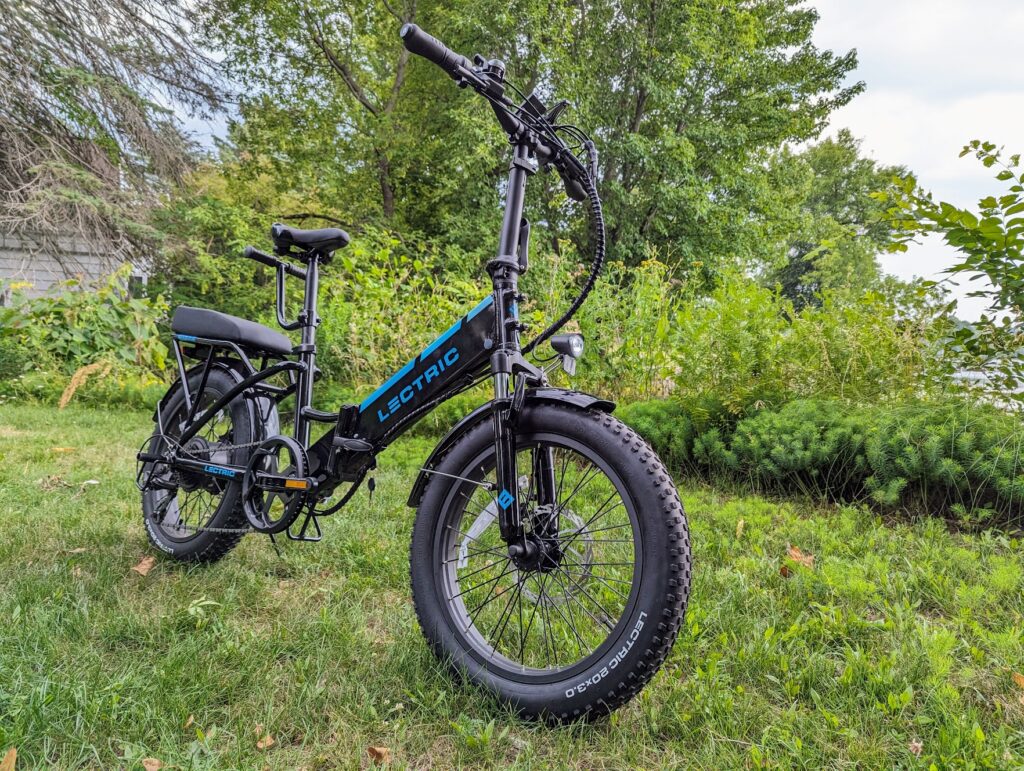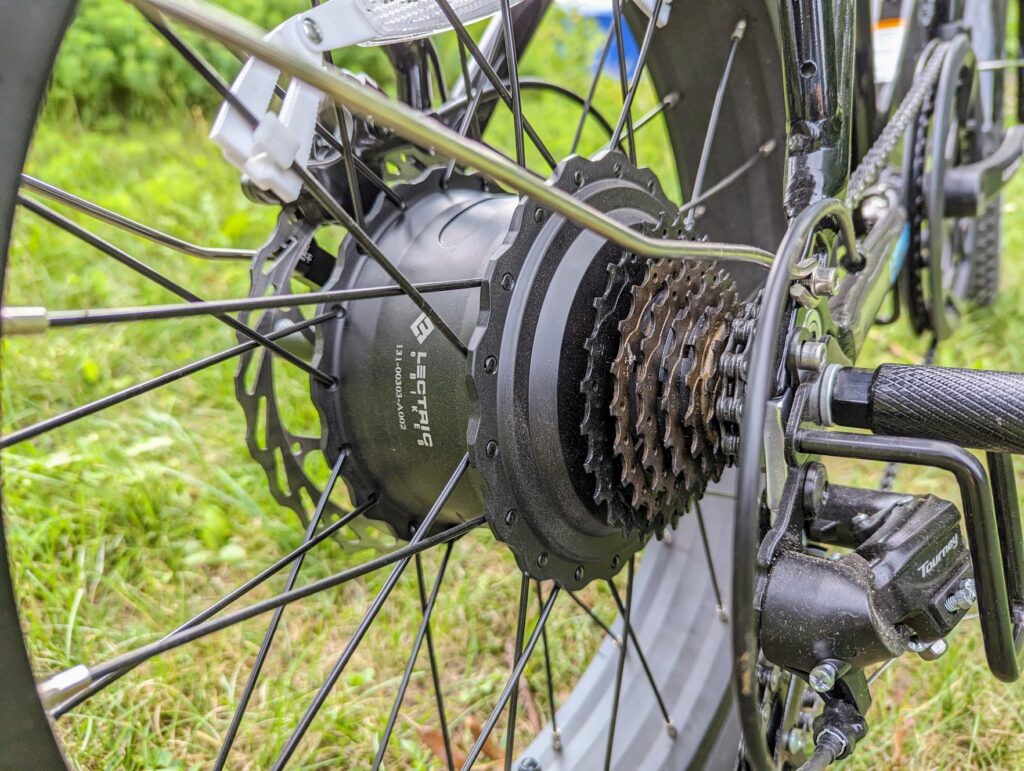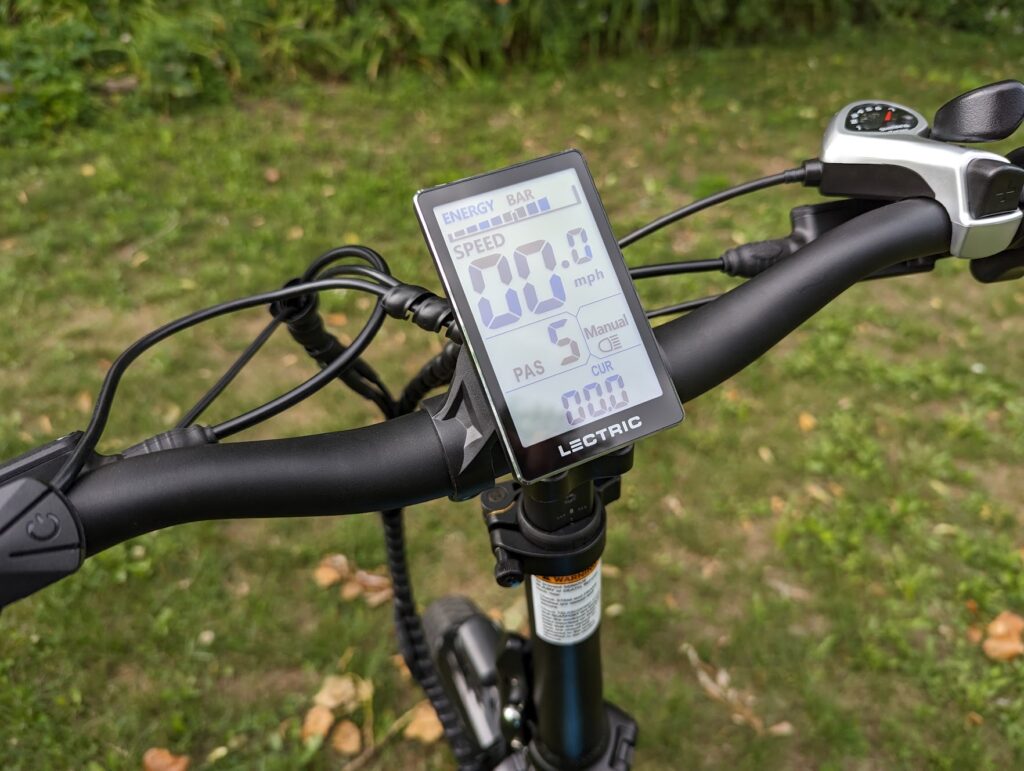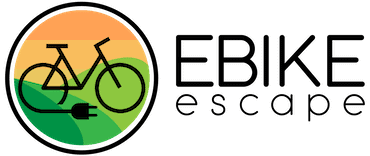
Lectric is the largest ebike company in America, having sold over 500,000 bikes. Their direct-to-consumer model provides high-value ebikes at approachable prices, backed by excellent customer service. In this 2024 Lectric XP 3.0 vs XPress 500 and 750 comparison, we examine three of Lectric’s top-selling models, covering use cases, specs, and what we do and don’t like about each bike. Let’s start by examining the overall design and shared features. By the end of this article, you’ll have a complete understanding of your options and feel confident you’re choosing the model that’s right for you.
Whether you focus on portability, refined handling, or raw motor power, this article has you covered.
Lectric XP 3.0 vs. XPress 500 & 750 Full Comparison Review
Lectric XP 3.0 vs XPress 500 and 750: An Overview



Lectric’s XP 3.0, XPress 500, and XPress 750 share core features like step-thru and step-over frame options, hydraulic disc brakes, front suspension, and Class 3 speeds. All three are UL-certified, ensuring safety and reliability, and deliver Lectric’s signature value and performance. These bikes are also easy to assemble at home though we do recommend taking it to a bike shop for a final check if you’re not confident. Our unboxing video’s below should give you a good idea of what to expect.
Their differences lie in each model’s focus. The XP 3.0 (standard range $999 | long-range $1,199) excels in portability with its folding frame and 20″ x 3″ fat tires, making it a great choice for commuters and RVers. Its rear rack, with a 150 lbs capacity, adds to its versatility. The cadence sensor provides quick power delivery, though the PWR+ torque sensors found on the XPress models (Xpress 500 $999 | XPress 750 $1,299) offer a more refined ride. Additionally, the upgraded motor technology and color LCD display on the XPress models highlight the added value of these newer designs.
Lectric XP 3.0: Compact, Portable, and Versatile







The XP 3.0 was my first ebike and a dependable commuter for over 600 miles. Its 500W motor and cadence sensor ensured I got to work on time without breaking a sweat. The folding frame let me store it in a utility closet or fit it in the trunk of our Ford Fusion, eliminating the need for a rack. It even fits neatly into a large tote for easy storage.
The rear rack adds versatility, letting me carry work essentials without a backpack. Riding with my son using the passenger pack is always a blast, and I’m excited to use it with my youngest next spring, thanks to its compatibility with Thule Yepp child seats. The fat tires, suspension fork, and comfort package (large saddle and suspension seatpost) smoothed out Wisconsin’s pothole-laden roads, making me feel confident on gravel paths and light trails.

Not everything is perfect with the XP 3.0. Power delivery drops noticeably after 70% battery drain, though this is less of an issue with the long-range 14Ah battery. Removing the battery requires folding the bike, which is clumsy despite its secure placement. The key placement under the frame is awkward, requiring crouching and navigating cables, and the key must remain in the bike while riding. Despite these quirks, the XP 3.0 remains a reliable, fun, and versatile daily companion.
Frame Options: Lectric XP 3.0


Offered in step-thru and step-over options, both frames share the same features with a few differences. The step-thru frame offers extra accessibility with its low standover height and a more compact feel, making it ideal for small to medium riders. The step-over frame allows larger riders to stretch out more while remaining easy to mount, with only a 5.5″ increase in standover height. See our sizing table below for more details.
Sizing Table: Lectric XP 3.0
Pros and Cons of the XP 3.0
Pros:
- Battery Options: Available in standard (10.4Ah) or long-range (14Ah)
- Folding Design: Eliminates the need for a bike rack
- Fat Tires and Front Suspension: Handle diverse terrains
- Sturdy Rack: Supports up to 150 lbs
- Affordability: With two battery options
- Adjustability: Adjustable stem and seatpost fit a wide range of riders
- Protected Battery: Securely placed inside the frame
Cons:
- Battery Removal: Requires folding the bike
- Motor Output Decline: Performance drops as battery level lowers
- Cadence Sensor Feel: Can be jerky at higher assist levels starting from a stop
- Key Placement: Awkwardly placed under the frame
- Key Requirement: Must remain in the bike to operate
Bottom Line: Why choose the XP 3.0?

Lectric’s XP 3.0 is their top-selling model for good reason. After all, it’s the bike that put Lectric on the map aiding them in becoming the largest seller of electric bikes in North America. It’s user-friendly, adaptable, and reliable, and it fits a wide range of riders while taking up a small footprint. As a bonus, Lectric often includes accessories like the comfort package or cargo package, letting you get a fully outfitted ebike at a great price.
Want to take a closer look? Check out our full review on Lectric’s XP 3.0.
Lectric XPress Models: Comfort vs. Performance


with 80mm of travel


with 180mm Rotors


integrated into the frame
The main differences between the XPress 500 and XPress 750 come down to motor strength and battery capacity. Both models deliver significant improvements in performance, showcasing Lectric’s dedication to delivering exceptional results at approachable prices. Both feature the PWR+ torque sensor, hydraulic disc brakes with 180mm rotors, a 7-speed Shimano Tourney drivetrain with thumb shifters, and a bottom-mounted battery, which is easier to remove than the XP 3.0’s design. They are available in either a step-thru or step-over frame, offering two distinct riding experiences.
Frame Options: XPress 500 and 750
Lectric XPress Step-Thru Frame

The step-thru frame prioritizes ergonomics and comfort. It features swept-back handlebars and a quick-release adjustable stem for an upright riding position. The low standover height (18.5″) makes mounting the bike very accessible. Only one color option, white.
Lectric XPress Step-Over Frame

The step-over frame has a traditional diamond shape with a fixed stem and flat handlebars. With a 28″ standover height, it is a good fit for taller riders or those seeking a more active riding position. The XPress step-over frame is only available in black. See our sizing table below for more details on both frames.


Which frame should you choose?
I found the step-thru frames ergonomics paired well with the XPress 500’s smooth, less aggressive performance. The forward leaning stance on the step-over frame suited the XPress 750’s extra power and acceleration. It is great that both frames are available for each model. Smaller riders who want the power of the XPress 750 can choose the step-thru frame for a better fit. See the sizing section below for a more detailed look at the fitment.
Sizing Table: XPress Step-Thru and Step Over Frames
XPress 500 (Step-Thru): Smooth, Quiet, and Comfortable


On solo rides, the XPress 500 with the step-thru frame provided my favorite riding experience. It has similar specs to the XP 3.0—both have a 500W motor and 10.4Ah battery capacity—but specs don’t tell the whole story. I expected similar performance, but I was pleasantly surprised by the improved power delivery and quieter motor. On a 20-mile ride up a mountain (650 ft climb), I still hit 19-20 mph on throttle alone near the end. The torque sensors offer smooth assistance, and the motor held me between 14-16 mph on steep climbs. It was easy to cruise in the low to mid 20’s on flatter ground.
The swept-back handlebars encouraged a comfortable, upright riding posture, and the quick-release adjustable stem made it easy to swap riders. The low standover height simplified mounting. Larger 27.5″ city tires and front suspension helped smooth out bumps.
Downsides are limited. The lack of front mounting points for a rack or basket reduces some commuting options. No included fenders or rear rack means budgeting extra if you need them. The optional rack’s 30 lbs capacity is less than the XP 3.0’s rack. Some riders may also prefer a twist throttle over the under-bar thumb throttle.
Pros and Cons of the XPress 500
Pros:
- Excellent Value: Great performance at a good price
- Hydraulic Disc Brakes: Strong stopping power
- Torque Sensor: Natural, responsive riding experience
- Adjustable Stem & Swept-Back Handlebars: Enhanced comfort
- Advanced Settings: Customize performance
Cons:
- No Included Fenders or Rear Rack: Must purchase as add-ons
- Limited Color Options: White for step-thru, black for step-over
- Thumb Throttle Only: Some riders prefer twist throttles
- No Front Mounting Points: Limits accessories
Bottom Line: Why choose the XPress 500?

The Lectric XPress 500 stands out as one of the best full-sized ebikes available at the $999 price point. It delivers a well-rounded package with a powerful motor, reliable battery life, and a comfortable riding experience—all at an exceptional value. With plenty of performance to meet the needs of most riders, it has earned its place as one of our favorite ebikes of 2024.
If you want to take a deeper dive, check out our full review on Lectric’s XPress 500.
Lectric XPress 750 (Step-Over): Powerful and Performance-Driven


The XPress 750’s motor performance impressed me with excellent acceleration and strong hill support. The torque sensors paired with the 750W motor felt almost as powerful as a cadence sensor with a smoother delivery, making pedaling effortless. Cruising at 25 mph was easy, and reaching 28 mph posed no issues. The more active riding position on the step-over frame gave me greater control during acceleration.
My main critique of the XPress 750 is the motor noise. More power usually means more noise, and the high-pitched whine can be distracting. Also, accessories like fenders and a rear rack may not be included, so check for sales or bundles.
Pros and Cons of the XPress 750
Pros:
- Powerful Motor: 750W rear hub motor peaking at 1,310W
- Torque Sensor: Natural, responsive ride at this price point
- Hydraulic Disc Brakes: 180mm rotors for reliable stopping power
- UL Certified: UL 2849 and UL 2271 for top safety standards
- Easy Assembly: User-friendly setup and excellent customer support
- Affordable Pricing: $1,299 without compromising features
Cons:
- No Included Fenders or Rear Rack: Additional purchase needed
- No Front Mounting Points: Limits front accessory options
- Basic Drivetrain Components: Shimano Tourney level
- Firm Saddle: May need an upgrade for extra comfort
Bottom Line: Why choose the XPress 750?

The XPress 750 offers great acceleration, a responsive torque sensor, and impressive performance at an approachable price. The 14Ah battery provides extra range and more consistent power over longer rides. Larger riders and those facing steep hills will appreciate the added support. If you value a quieter motor and are satisfied with a 500W setup, the XPress 500 is a solid choice.
For detailed info on this model, check out our full review on Lectric’s XPress 750.
Specs Comparison:
Lectric XP 3.0 vs XPress 500 and 750
Now that you’ve explored each model individually, here’s a quick side-by-side snapshot of their key specs.
Performance Comparison:
Lectric XP 3.0 vs XPress 500 and 750
We tested all three models extensively. Two riders, both 6′ tall but at different weights, participated. Ryan, a lighter rider, performed the hill climb tests. Myles, a mid-heavy rider, performed the acceleration tests. Here is how their capabilities stack up.


Acceleration Tests (40° day)
- Throttle-Only Acceleration:
- XP 3.0: Reached 18 mph in 11s
- XPress 500: Reached 20 mph in 11s
- XPress 750: Reached 20 mph in 10s
- 0-28 MPH Pedal Assist:
- XP 3.0: 28 mph in 15s
- XPress 500: 28 mph in 14s
- XPress 750: 28 mph in 12s
Hill Climb Tests (174ft Climb, Average 8.2% grade over 0.4 miles)
- Throttle Only:
- XP 3.0: Minimum ~14 mph
- XPress 500: Minimum ~15 mph
- XPress 750: Minimum ~16 mph
- Pedal Assist:
- XP 3.0: Held 16-17 mph with moderate effort
- XPress 500: Maintained ~13 mph with light effort
- XPress 750: Sustained 16-17 mph with ease
Key Findings
The XP 3.0 is capable at climbing hills but lags behind both XPress models in acceleration. The XPress 500 delivers smooth, impressive support and sits between the XP 3.0 and XPress 750‘s performances. The XPress 750 leads in power and acceleration and offers the best support on hills.
Conclusion: Lectric XP 3.0 vs XPress 500 and 750




The XP 3.0 is an excellent option if you prioritize portability and versatility, especially for commuters and RVers. The XPress 500 shines as a quiet, smooth performer ideal for recreational rides and city commutes. For those who demand maximum power and performance on hills or during acceleration, the XPress 750 is the standout choice, albeit with a louder motor.
No matter which model you pick, Lectric offers a high-quality ebike tailored to your needs, backed by excellent customer service. As shown in this 2024 Lectric XP 3.0 vs XPress 500 and 750 comparison, each model serves a different purpose. If you are interested in one of these models, using our affiliate link is a cost-free way to support the work we do. If these aren’t the models you are looking for, check out our other Lectric reviews and subscribe to our YouTube channel for our video reviews!

